Mastering the Surf Pop-Up: Techniques and Insights
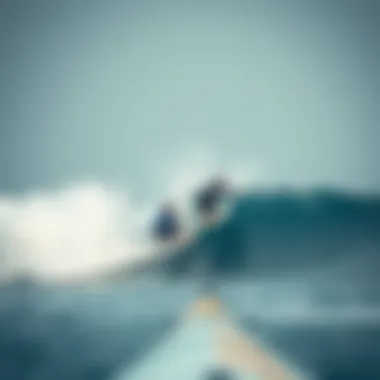

Intro
Surfing is not just a sport; it’s a lifestyle that beckons enthusiasts to dance with the waves and embrace the ocean’s untamed energy. One pivotal skill that separates the casual voyagers from the true wave riders is the pop-up. This technique is the bridge from crouching on your board to standing tall, poised to ride the surf.
Without a solid understanding of how to pop up correctly, a surfer’s performance can be hindered, making it crucial to grasp not only the mechanics but also the nuances involved.
In this guide, we will dive into the intricate details of mastering the surf pop-up. We will discuss the gear and equipment essential for every surfer, explore techniques tailored for beginners and advanced surfers alike, and provide valuable insights into adjusting the pop-up technique based on different surf conditions. Through focused exploration, this guide aims to enhance overall surfing proficiency and enjoyment.
Let’s embark on this journey to refine your skills and elevate your surfing experience!
Gear and Equipment
Before you hop on your board, your tools of the trade play a significant role in ensuring your success on the waves. From surfboards crafted with cutting-edge technology to essential accessories, having the right gear makes a world of difference.
Latest Surfboard Technologies
When it comes to surfboards, the innovations in materials and designs are simply mind-boggling. Modern surfboards utilize advanced materials such as epoxy resin that enhance buoyancy while providing durability. Brands like Channel Islands have been pioneering in shaping boards that cater to various skill levels.
- Shortboards are preferred for their maneuverability and speed, perfect for experienced surfers looking to pull off tricks.
- Longboards offer stability and ease, ideal for beginners who are just learning how to ride.
- Fish boards strike a balance, engineered for versatility and better performance in smaller waves.
Selecting the right board contributes to not only your comfort but also your success rate while practicing the pop-up.
Essential Accessories for Every Surfer
Besides the board itself, there are several accessories that elevate the surfing experience and safety:
- Leash: A must-have to keep your board nearby and prevent accidents.
- Wetsuit: Essential for maintaining body temperature in cooler waters.
- Wax: Crucial for grip on your board; a slight layer can drastically change your stability.
- Surf Hat or Sunscreen: Protect yourself from harmful UV rays, especially during long sessions.
Choosing the right mix of equipment and accessories is part and parcel of your journey toward mastering the surf pop-up.
Surf Techniques and Skills
Every surfer, regardless of skill level, must continuously work on techniques to improve. Navigating your journey through the waters involves both essential beginner techniques and more advanced maneuvers.
Beginner Surfing Techniques
Starting with the basics will allow you to lay a firm foundation.
- Paddling: A proper paddling technique is essential for speed and catching waves effectively.
- Positioning: Learning how to position your body on the board for optimal buoyancy and balance is crucial for a successful pop-up.
Mastering the pop-up can be boiled down to three core steps:
- Engage your core as you prepare to rise.
- Push off with your hands, ensuring you distribute your weight evenly.
- Stand up quickly, bringing your feet under your body while maintaining balance.
Advanced Maneuvers for Experienced Surfers
Once you feel comfortable with the basics, diving into advanced techniques is worthwhile. Here, refining your pop-up can lead to higher performance in various surf conditions.
- Dynamic Pop-Up: This involves a more explosive jump to gain immediate control over your board.
- Traveling Adjustments: Vary your pop-up to match the wave type; for bigger waves, you may need to pop up quicker and focus on stability.
"The pop-up is everything. Master it, and the rest will fall into place."
In wrapping up this section, whether you are starting your surfing journey or pushing the boundaries as an experienced rider, the surf pop-up is integral to your overall experience. The right gear supports these techniques, refining your ability and increasing enjoyment on every wave.
Understanding the Surf Pop-Up
The surf pop-up is a pivotal skill in surfing, marking the transition from lying on the board to standing upright as the wave carries you forward. Getting this transition right is not just about looking cool; it’s fundamentally about control and efficiency on the water. A good pop-up enables surfers to harness the energy of a wave efficiently, allowing them to navigate and ride with greater speed and fluidity. As a surfer, regardless of experience level, improving your pop-up can significantly enhance your performance and enjoyment of the sport.
Definition and Importance
At its core, the surf pop-up is a maneuver where the surfer moves quickly from a prone position to a standing position in one fluid motion. This movement is crucial for gaining momentum as the wave breaks. The importance of mastering this maneuver cannot be overstated. If you imagine the pop-up as the heartbeat of surfing, you get a sense of its significance. When executed poorly, it can lead to wipeouts, missed waves, or less enjoyable sessions in the surf.
Efficient pop-ups contribute to better control over the board, allowing surfers to integrate seamlessly into the dynamics of the wave. The energy harnessed from the wave can differ remarkably based on how well your pop-up is executed. A well-timed pop-up ensures you’re positioned to ride the wave’s face optimally, which is integral for skillful surfing.
Historical Context
Surfing, as a sport, has roots that stretch back thousands of years, originating from Polynesian voyagers who rode waves on wooden planks. The art of standing on a surfboard and navigating waves has evolved tremendously over the years. Early surfers used longboards where stability was prioritized over maneuverability. However, with the evolution of surfboards, the dynamics of maneuvering have shifted.
In the 20th century, with the rise of foamy shortboards, the demand for a swift and agile pop-up became evident. Surfers began to notice how important a quick transition to standing was in allowing them to take full advantage of the wave before it dissipated. Over time, various styles and techniques for the pop-up emerged, influenced by surfing conditions, board types, and cultural innovations.
The pop-up is not merely a technical skill; it carries a rich history that reflects the evolution of surfing culture itself. It symbolizes the drive for progress in surfing as both an art and a sport. Understanding its historical context can deepen a surfer's appreciation for the skill and might inspire them to perfect their technique.
"Mastering the pop-up is akin to walking on the tightrope of balance and timing, a vital dance that every surfer must master to glide atop the waves."
In the current surf community, tutorials, workshops, and dedicated coaches emphasize pop-up techniques reflecting this rich legacy, guiding new generations of surfers to merge tradition with modernity in their craft.
Mechanics of the Pop-Up
Understanding the mechanics of the pop-up is fundamental for surfers. It serves as a bridge between the often cumbersome prone position and the balanced stance required for riding a wave. Mastering these mechanics not only elevates your surfing skills but also enhances your confidence on the water. A proficient pop-up paves the way for smoother transitions, allowing surfers to react swiftly to changing wave conditions. This section will break down critical elements such as body position, timing, and coordination—all essential for executing a successful pop-up.
Body Positioning
Prone Position Basics
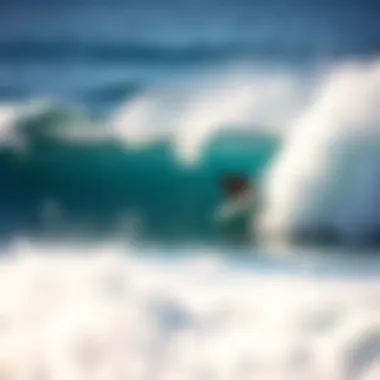
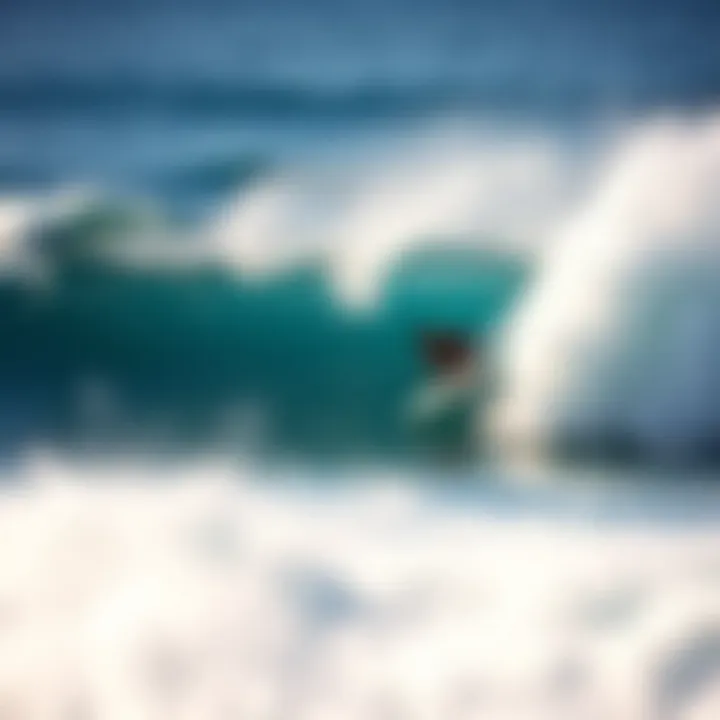
At the heart of the pop-up is the prone position, where a surfer lies flat on their board, awaiting the right moment to spring into action. This position lays the groundwork for a strong and agile transition to an upright stance. It's crucial for surfers to understand how their body should feel while in this position. Ideally, the torso should be centered, with the legs extended behind. This balanced distribution of weight provides both stability and maneuverability.
One key characteristic of the prone position is the alignment of your body with the board. When done correctly, it helps in distributing the surfer’s weight evenly, minimizing drag as they paddle forward. A common mistake here involves overextending the arms or too arching the back, leading to unnecessary strain. It's beneficial because a solid prone position allows for quicker reactions when a wave arrives, providing an edge in timing the pop-up—an absolute necessity for maintaining control while riding the wave.
However, the disadvantage could be that, without practice, surfers may find themselves too rigid or unresponsive in this position, making the transition to standing more challenging during live surf conditions.
Hand Placement and Grip
The nuances of hand placement can make or break a successful pop-up. When you're in the prone position, where you place your hands is paramount for the efficiency of the movement. Typically, hands should be placed near the shoulders, palms down, providing a solid grip on the board as you prepare to launch yourself upright. A notable aspect of this is that improper grip can lead to unnecessary slips, ultimately compromising your balance as you rise.
Having your hands positioned correctly not only maximizes power but also offers better leverage. With this grip, surfers can apply the right amount of force needed to lift their bodies from the board while keeping their center of gravity low. The advantage is clear: a good hand grip facilitates a quicker and more controlled transition. On the flip side, a less than optimal grip could lead to wobbly attempts at popping up and even falling back into the water, which can be frustrating and demoralizing for beginners.
Timing and Coordination
Recognizing the Wave's Energy
Timing the pop-up hinges on the surfer's ability to recognize the wave's energy. Understanding the nuances of how a wave builds can inform a surfer's decision when to pop up. Waves can have different personalities; some may peak gently, while others are fierce and symmetrical. Recognizing these patterns is key.
This skill not only enhances overall performance but also significantly reduces the chances of wiping out. The ability to ‘read’ a wave can also increase the likelihood of catching it successfully, offering surfers a more rewarding experience. However, for novice surfers, missing this understanding can result in ill-timed pop-ups and remedial corrections that cut into ride time.
Synchronizing Paddling and Pop-Up
Successfully synchronizing paddling with the pop-up is like dancing with the ocean. It's a crucial aspect that underscores the harmony between movements to achieve a seamless transition. When paddling, you need to build momentum, and as the wave rises, that’s when the pop-up should occur. This synchronization requires a blend of strength and rhythm, ultimately leading to a smoother ride.
This technique relates closely to body movement. When paddling and pop-up are executed together, it creates a fluid motion that allows the surfer to capitalize on the wave’s power. Getting it right not only feels rewarding but is immensely beneficial, as it enhances forward thrust and stabilizes the board at the crest of the wave. Conversely, misaligning these movements can lead to an awkward fall or, worse, completely missing the wave.
In this process, meticulous attention is essential—nothing less than a finely-tuned awareness of both your body and the energies of the wave will do.
With these fundamentals in mind, surfers can elevate their overall technique and enjoyment of the sport, setting the stage for an engaging surfing experience.
Techniques for an Effective Pop-Up
Mastering the surf pop-up is not just about the basics; it is also about refining the way you transition from lying on your board to standing tall and riding the wave. The techniques discussed herein serve as the backbone for both novice surfers and seasoned riders. We will delve into traditional forms, explore alternative methods, and dissect when each technique shines brightest.
These techniques are essential for anyone serious about enhancing their surfing experience. Understanding what works best can elevate your skills, boost your confidence, and ultimately lead to more successful rides. Remember, every surfer has their flavor of style, and the techniques you choose can greatly influence your performance on different surf conditions.
Traditional Pop-Up Technique
The traditional pop-up technique is a time-tested method that has been ingrained in surfing culture. It begins from a prone position, where the surfer uses their arms to push off the board as they bring their feet underneath them. The essence of this method lies in the seamless flow and speed at which you can execute it. A well-timed, smooth pop-up can be the difference between catching a wave gracefully or falling flat on your face.
To execute this technique effectively, strength and mobility are critical. Engaging your core and aligning your body correctly increases not just your speed but also your control once you’re up. A crucial tip is to keep your eyes focused on where you want to go; this aids in maintaining balance. When done right, this traditional method serves as a fundamental skill that every surfer can master and harness.
Alternative Methods
While the traditional pop-up is a staple technique, exploring alternative methods can open new avenues in surfing. Here, we’ll examine two noteworthy approaches: Drop Knee Variations and the Turtle Roll Approach. Each presents unique characteristics and advantages, providing surfers with options depending on their individuality and the conditions they face.
Drop Knee Variations
The Drop Knee Variation stands out for its adaptability, especially in swirling beach breaks or smaller waves. This technique involves dropping down to one knee instead of assuming a fully upright stance right away. A key characteristic of this method is its ease of transition, allowing surfers to regain balance while still maneuvering through critical sections of a wave.
The beauty of drop knee lies in its position; by lowering yourself onto one knee, you lower your center of gravity, enhancing stability. This can be particularly beneficial in crowded surf spots where quick directional changes are often required. However, it does demand a different level of comfort and agility, as keeping a fluid motion while dropping can be challenging for beginners. Still, the advantages it offers in terms of flexibility make it a favorite among many surfers who are keen on mixing up their styles.
Turtle Roll Approach
The Turtle Roll approach, though less conventional, offers unique benefits for navigating larger waves and turbulent waters. It involves flipping the board upside down while lying on it, allowing the wave to pass over you. A standout feature of the Turtle Roll is its ability to minimize the risk of losing your board in choppy conditions, as it keeps the board closer and more controlled at all times.
This technique shines in bigger swells where traditional paddling can become daunting. The maneuver gets you below the wave’s lip, avoiding a wipeout. Still, it does require a level of preparation. Surfers must develop a solid sense of timing and breath control to execute the Turtle Roll effectively. If you find yourself faced with monstrous waves, this approach can be your saving grace.
By examining both traditional and alternative techniques, surfers can enhance their skill set, becoming more versatile in different conditions. Choosing a method that not only suits your style but also adapts to the environment can make all the difference between a long ride and a short tumble.
Common Mistakes to Avoid
The surf pop-up is a dance between time, precision, and physical alignment. Skirting common pitfalls can make the difference between soaring on waves or crashing into the surf. Recognizing these mistakes not only enhances a surfer's technique but also nurtures confidence in their skills. In this segment, we expose three significant blunders that can derail the pop-up process: poor timing, incorrect hand placement, and a wobbly stance.
Poor Timing
Timing is like the rhythm of a well-orchestrated symphony. It’s crucial for a successful pop-up. When the wave begins to lift the board, a surfer must synchronize their movement. If you wait too long, the wave's energy will have dissipated, leaving you floundering or falling off the board. Conversely, popping up too early means you’ll miss the wave's sweet spot, leading to an awkward or even dangerous situation.
To improve timing:
- Observe the waves: Familiarize yourself with how the water behaves before you hit the surf.
- Practice paddling efficiently: The moment you feel the wave's lift under you, it’s game time!
- Use visual cues: Look for the lip of the wave or the moment when the white water starts rolling over.
Utilizing these strategies will not only improve your timing but help elevate your surfing overall.
Incorrect Hand Placement
Hand placement during the pop-up is as essential as the car keys are to the ignition. If you don’t get this right, you risk an unstable surf experience. Many beginners often plant their hands too far back, resulting in a skewed center of gravity. This misalignment creates unnecessary strain and can lead to falls after just a few moments of standing.
To set your hands correctly:
- Keep your hands shoulder-width apart: This will help with balance.
- Position your hands near your chest: This will enable powerful push-offs when the time comes.
- Check your grip: Ensure your fingers and palms are firmly placed on the board, ready to propel upwards smoothly.
By mastering this fundamental aspect, surfers can enhance their overall balance and control.
Wobbly Stance
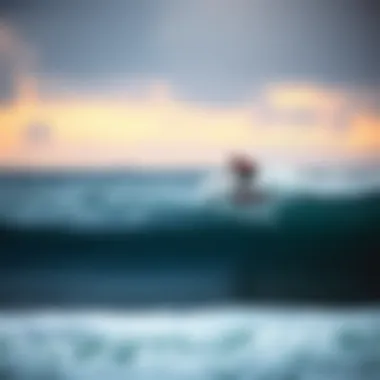
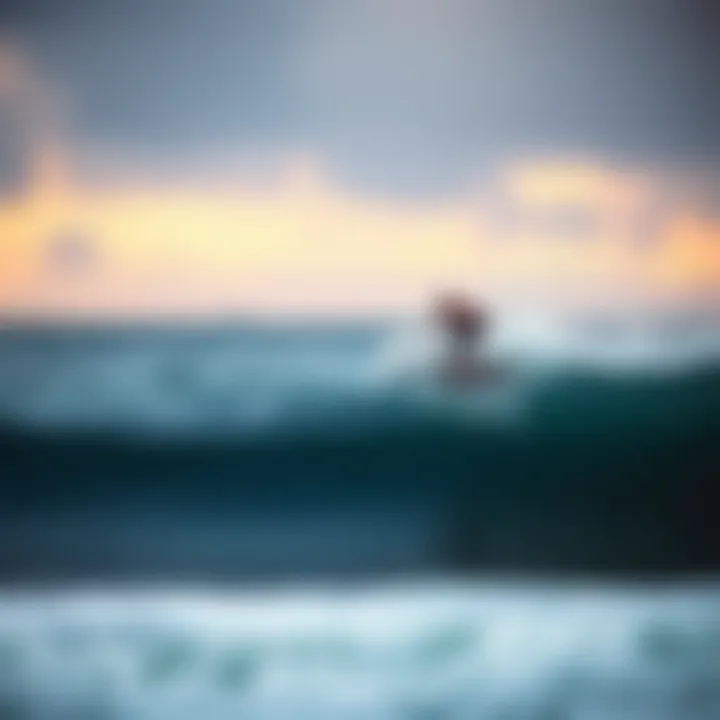
Once you rise to your feet, the battle is not yet over. A wobbly stance can throw a surfer right back into the drink. It’s the classic mistake of standing with a narrow or overly tense position, which can send you tumbling with the slightest shift in weight. A proper stance is fundamental for maintaining flow and balance over the waves.
To establish a stable stance:
- Feet shoulder-width apart: This provides a solid base.
- Bend your knees slightly: Lowering your center of gravity will enhance stability.
- Engage your core: A strong core aids in better control and strength while surfing.
"The art of surfing lies in the balance between energy and control."
Learn more about surf techniques and common mistakes on resources like Wikipedia or visit your local surf school for hands-on guidance.
Drills for Practice
Practicing drills is vital for surfers looking to improve their pop-up technique. Regular drills help develop muscle memory, instill essential habits, and create a seamless transition from paddling to standing. A strong emphasis on drills not only fine-tunes the physical aspect of surfing but also plays a key role in boosting a surfer's confidence in the water. By incorporating a variety of drills, surfers can address their weaknesses and lay a solid foundation for consistent performance on the waves.
Dry Land Exercises
Pop-Up Practice with a Mat
Practicing the pop-up on a mat simulates the movement without the added challenge of water dynamics. This drill allows surfers to focus solely on mechanics. The beauty of this practice method is its accessibility; anyone can do it at home or in a park.
One of the key characteristics of the mat practice is that it encourages repetition in a controlled environment. Surfers can experiment with their technique, refining their muscle coordination and balance. A significant advantage is that it reduces the intimidation factor, making it great for beginners and those still gaining confidence.
However, a disadvantage lies in the lack of real-time feedback from surf conditions. Surfers should treat mat practice as an adjunct to in-water training rather than a complete substitute. The physical sensation of riding a wave differs greatly from laying on a mat, so this practice should complement in-water drills.
Balance Training Techniques
Balance is crucial for surfers, who need to maintain stability while riding unpredictable waves. Engaging in specific balance training techniques prepares surfers for the dynamic nature of surfing. These exercises can range from using a balance board to practicing yoga poses that enhance core strength and stability.
The highlight of balance training is its ability to challenge the stabilizing muscles. It sharpens a surfer’s overall coordination and equilibrium. Incorporating balance drills is beneficial because it equips surfers with the necessary skills to respond agilely on the board. Plus, these exercises can be done anywhere, adding flexibility to practice schedules.
However, balance training can sometimes induce frustration, especially for beginners struggling with coordination. Surfers must be patient and remember that gripping the surfboard with confidence takes time and perseverance.
In-Water Drills
Pop-Up Timing in White Water
Practicing pop-up timing in white water offers a different set of challenges compared to flat water. The turbulence and movement of the waves force surfers to adapt and time their pop-up perfectly. It teaches surfers to read the wave's energy and react accordingly.
The unique aspect of this drill is that it mimics real surf scenarios, allowing the surfer to experience the rush and unpredictability of actual waves. A major advantage of this approach is the immediate feedback. Surfers can feel when their timing is off and make adjustments in real time.
On the downside, the chaotic nature of white water can overwhelm newer surfers who haven’t yet developed their balance. Patience is key as it might take several tries to “get it right.” But once a surfer learns how to pop up under more challenging conditions, it builds confidence immensely.
Utilizing a Surf Coach
Working with a surf coach can exponentially enhance a surfer’s learning curve. Coaches provide personalized feedback that guides an individual through the nuances of technique, emphasizing strength areas while addressing weaknesses. A good coach tailors their approach to fit a surfer’s unique style and skills.
One major advantage is the experienced eye that a coach brings, different from peers who might not offer the technical insight that a trained professional can. Moreover, they can design structured practice sessions that keep surfers motivated and on track.
The only downside? Some surfers may find this option cost-prohibitive or intimidating, especially if they are new. Despite the challenges, the personalized guidance can make a substantial difference in mastering skills and maintaining motivation for progress.
Adapting the Pop-Up for Different Conditions
When it comes to surfing, each wave has its own character. The ability to adapt your pop-up technique to different conditions is crucial for improving your overall performance and making the most of every wave. Recognizing how factors like wave size, shape, and power vary can greatly influence how you approach the pop-up. This adaptability not only fosters confidence but also helps build a more responsive riding style. Without this understanding, attempting to execute the same pop-up technique in every situation can lead to missed opportunities or even wipeouts.
Small Waves
In smaller waves, your approach to the pop-up requires a lighter touch and quicker movements. The energy in smaller waves can feel more subdued, demanding a different technique to ensure you get up on your feet efficiently. Here are some key aspects to consider:
- Paddle Timing: In smaller surf, timing your paddling is essential. As the wave approaches, you'll want to synchronize your paddling speed with the wave's energy. If you paddle too hard or too late, you could miss the lift as the wave passes under you.
- Quick Transition: Since small waves generally provide less power, you need to pop up quicker. Choose your moment right as the wave starts to lift you, and get to your feet swiftly to maintain that momentum.
- Lower Center of Gravity: Keeping your knees slightly bent and your center of gravity lower can help maintain balance. This stance allows you to adjust more easily to the wave movement, which is particularly helpful when riding smaller, less powerful waves.
In summary, adapting your pop-up for small waves revolves around timing, a quick transition, and maintaining balance. Simple adjustments can make all the difference in your ride.
Big Waves
Big waves present a whole new set of challenges and require a distinct pop-up technique compared to smaller swells. The sheer force and unpredictability can be daunting, but proper adaptation is what sets seasoned surfers apart. Here are some important elements to keep in mind:
- Increased Power: The energy behind large waves is formidable. You need to be ready to harness that energy by popping up with purpose. Failing to capitalize on the wave's push can send you tumbling.
- Body Positioning: As you paddle into a larger wave, ensure that you are in a proper position. This means keeping your weight forward on the board to avoid being thrown backward once the wave hits. Be prepared to adjust your positioning on the board as you execute the pop-up.
- Angle of Takeoff: The angle at which you pop up matters significantly. Instead of rising straight up, you may want to angle your body towards the direction of the wave. This angle allows you to take full advantage of the wave's energy, which is crucial for maintaining speed and control.
- Mental Preparation: Riding larger waves often comes with anxiety. Visualize your pop-up technique before taking off. This mental rehearsal can alleviate pressure and help you focus on execution.
To wrap it up, adapting the pop-up for big waves requires an understanding of power, strategic body positioning, and favorable angles for takeoff. It’s the combination of these elements that keeps you on your board rather than in the water.
Choosing the Right Surfboard
Selecting the appropriate surfboard is a pivotal decision for any surfer aiming to master the pop-up. The right board influences not just the effectiveness of your maneuver, but also your overall experience on the waves. An ill-suited board can lead to frustration during your attempts, making each wipeout a more daunting task. Whether you're a newcomer or have some experience under your belt, understanding the nuances of different surfboards is essential for refining your skills and enhancing your enjoyment in the water.
Board Types and Their Impact on Pop-Up
When it comes to surfboards, they aren’t all created equal. The type of board you chose can have a direct impact on your ability to perform a clean pop-up. Here are a few common types:
- Shortboards: Designed for agility and speed, these boards are favored by advanced surfers. They provide less volume, which can make popping up a bit harder for beginners, yet with practice, experienced surfers can maneuver swiftly in tight spaces.
- Funboards: A middle ground between shortboards and longboards, funboards offer more stability and are typically easier for novice surfers to pop up on. Their broader design provides a more forgiving experience when transitioning to a standing position.
- Longboards: Perfect for those who prioritize stability, longboards feature a wider surface area. This makes the pop-up feel less intimidating, giving you ample room to find your footing. However, they can be cumbersome in steeper waves due to their size.
Each type has its own advantages and disadvantages regarding how well they facilitate the pop-up. It’s crucial to identify which type suits not only your current skill level but also your surfing style.
Experimenting with Sizes
Size matters when it comes to surfboards, and experimenting with different sizes can greatly affect your pop-up effectiveness. Surfboards come in various lengths, widths, and thicknesses. Here are a few considerations:
- Length: Longer boards generally provide more stability but may complicate a quick pop-up. Shorter boards can be easier to pop up on, but they demand better balance and coordination.
- Width: A wider board usually means increased surface area which can assist in stabilization at the pop-up stage. However, this could also mean a heavier transition into a standing position.
- Thickness: Thicker boards float better, which is advantageous for beginners. But too much thickness may limit your agility, especially during rapid maneuvers.
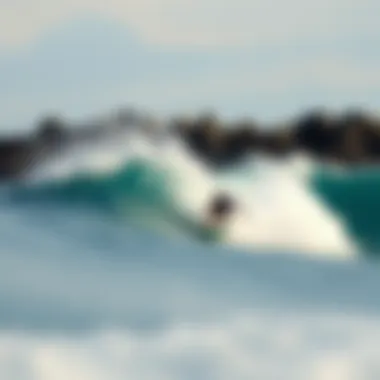
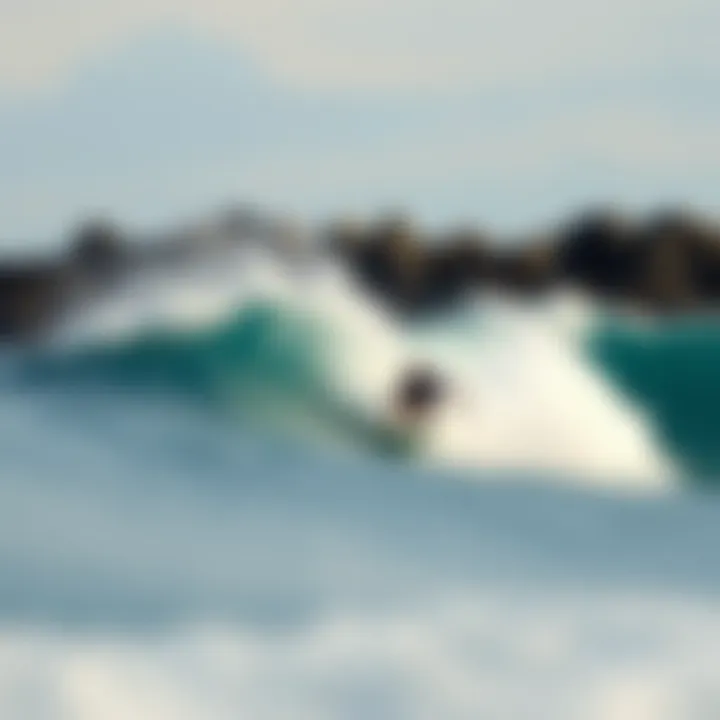
It’s worth noting that your personal body type and weight also play a role in selecting the appropriate size. A heavier surfer may benefit from a thicker or longer board to ensure sufficient buoyancy, while lighter surfers might find shorter boards easier to control.
"The best way to find what works for you is to try various boards. What fits one surfer perfectly might leave another feeling awkward."
A good approach is to test different sizes during your surf sessions. You can rent boards before making a purchase, allowing you to discover what feels best under your feet.
In summary, the right surfboard enhances the performance of your pop-up and leads to a more fulfilling surfing experience. As you dive deeper into this exhilarating sport, reflect on the board’s design in relation to your skills, body type, and the conditions you plan on surfing. By selecting wisely and experimenting with sizes, you set the stage for both improvement and enjoyment.
Mental Preparation and Focus
In the grand tapestry of surfing, mental preparation holds its own alongside physical prowess. The surf pop-up, a pivotal maneuver for every surfer, entails more than just an athletic feat; it calls for focus, calmness, and mental clarity. When a surfer transitions from lying flat to standing on the board, it’s essential that the mind is just as aligned as the body. This mental synchronization helps surfers not only perform better but also enjoy the ride, reducing fear and enhancing the ability to adapt on the fly.
Visualization Techniques
Visualizing success can be a powerful tool in surfing, especially when it comes to mastering the pop-up. Surfers can begin with mental imagery of themselves gliding smoothly from prone to standing position. This isn’t merely daydreaming—it’s a focused endeavor. Here are steps to effectively implement visualization:
- Find a Quiet Space: Start in a comfortable environment free from distractions, whether indoors or on the beach.
- Close Your Eyes and Breathe: Take a few deep breaths to calm your mind. Focus on the rhythm of your breath to center your thoughts.
- Visualize the Pop-Up: Picture each movement clearly. Imagine paddling into the wave, feeling its energy, then performing the pop-up smoothly. Envision the sensations: the rush of the wind, the stability of your board, and the view ahead.
- Repeat Regularly: Consistent practice leads to familiarity, which can translate well into action in the water.
By reinforcing a mental picture of successful execution, surfers can build their confidence, which often leads to improved performance under real conditions.
Dealing with Anxiety
Anxiety is a familiar companion for surfers, especially when facing unfamiliar waves. This nervousness can impede the ability to pop up effectively, turning a golden ride into a frustrating wipeout. However, managing anxiety is both a skill and a necessity for every aspiring surfer. Here’s how to navigate through the nervous waters of anxiety:
- Recognize Triggers: Identify what specifically causes anxiety. Is it paddle fatigue, the fear of falling, or the size of the waves? Understanding the root cause is the first step in tackling it.
- Focus on the Moment: Instead of getting lost in worries about what might happen, concentrate on the present. Notice the feel of the water, the sound of the waves, and the warmth of the sun on your skin.
- Preparation and Practice: The more familiar you are with your technique, the more confidence you’ll build. This readiness can considerably diminish anxiety.
- Positive Affirmations: Before heading into the water, tell yourself that you’re prepared. Something as simple as "I can do this" can reinforce a positive mindset.
Handling anxiety requires persistence and practice, turning a seemingly insurmountable obstacle into a stepping stone towards becoming a better surfer.
Memory is a funny thing; once I learned to visualize my pop-up, each session felt like a fresh canvas—the waves my paint and my board the brush.
Community and Resources
In the world of surfing, the journey often extends beyond the ocean waves and is heavily influenced by the community surrounding it. Connecting with fellow surfers opens doors to learning opportunities, sharing experiences, and receiving insights that can't be found in books. Resources available to surfers, ranging from local surf schools to online forums, play an essential role in the development of skills, including the crucial surf pop-up. This section explores how engaging with the surfing community can enhance your understanding and execution of the pop-up technique, providing invaluable support for both beginners and seasoned surfers alike.
Surf Schools and Workshops
Surf schools and workshops are not just about catching waves; they serve as a foundational element for mastering techniques like the pop-up. One-on-one instruction from experienced coaches helps surfers understand their unique style, strengths, and weaknesses.
- Here are some benefits of attending these schools:
- Tailored Feedback: Instructors can provide personalized advice on body mechanics and timing, helping you refine your pop-up.
- Structured Learning: Many schools follow a progression, ensuring you build your skills incrementally.
- Networking Opportunities: Meet fellow surfers who share your passion or even form lasting friendships.
Look for schools that offer specialized workshops focusing on the surf pop-up, as these settings usually have smaller class sizes. This allows for more detailed instruction and a chance to ask questions specific to your struggles or concerns. Websites such as surfline.com can provide listings of reputable schools and user-submitted reviews.
Online Forums and References
In our digital age, online forums offer a rich tapestry of shared knowledge among surfers worldwide. Platforms such as Reddit can be goldmines for tips, tricks, and real-world experiences. Surfers can post specific questions about the pop-up and receive diverse responses from experienced individuals.
- Comprehensive forums often provide:
- Actionable Insights: Users share their successes and challenges, offering real-time feedback on the pop-up technique.
- Resource Sharing: Many members share articles, videos, or personal coaching tips that could help you grasp the nuances of the pop-up.
- Community Support: The virtual nature of forums means that surfers from different regions can connect and assist each other, building a sense of camaraderie.
Engage with platforms like reddit.com/r/surfing, where surfers actively discuss and share their experiences. Utilizing these online resources broadens your knowledge base and keeps you engaged with the surf community regardless of your location.
"A surfer's journey is not only defined by waves but also by the connections forged along the way."
Overall, diving into the surf community and tapping into various resources provides support, education, and guidance as you master the pop-up and navigate the larger surfing landscape.
Evaluating Progress
Evaluating progress in mastering the surf pop-up is like taking a snapshot of your journey on the waves. It holds significance not just for the physical skill set, but also for the mental and emotional aspects of surfing. Your ability to pop up effectively can immensely enhance your overall surfing experience, instilling confidence and encouraging further exploration of your surfing potential.
When you assess your progress, you open the door to understanding where you stand in your surfing journey. It helps you identify areas that require more attention and gives you a sense of accomplishment as you witness improvement over time. Regular evaluation can also unify your training efforts and refresh your motivation.
Key elements to consider while evaluating progress include:
- Consistency: Are you able to pop up smoothly each time?
- Speed: How quickly can you transition from prone to standing?
- Stability: Can you maintain balance once you are up?
- Adaptability: Are you able to adjust your pop-up technique according to different wave conditions?
Ultimately, evaluating progress serves as a guide, shaping your practice sessions to focus on specific techniques and refining your surfing prowess.
Self-Assessment Techniques
Self-assessment is an essential tool on your path to surfing mastery. This process allows you to analyze your own performance and determine what works and what needs an overhaul. One way to approach this is through the use of a personal surfing journal. You might jot down details like the conditions of the day, the waves you attempted to ride, and the details of your takeoff.
Here are a few self-assessment techniques to consider:
- Video Analysis: Record yourself while practicing. Watching the footage can reveal unnoticeable errors in form or timing.
- Setting Benchmarks: Establish specific goals, like achieving a successful pop-up within a certain time frame or under varying surf conditions.
- Daily Reflection: After each surf, take a moment to reflect on your performance. What felt solid? Where did you falter?
By participating in this self-reflective practice, you gain clarity on your progress and can make informed decisions on how to sharpen your techniques.
Feedback from Peers
Feedback from fellow surfers can provide an external perspective that self-assessment might miss. Other surfers, be it friends or instructors, can offer valuable insights and constructive criticism, helping to refine your technique further. A supportive community enhances your surfing journey significantly.
To gain effective feedback, consider doing the following:
- Surf with Friends: Invite skilled surfers to join you at the beach. Their observations can point out difficulties you may not be aware of.
- Engage in Group Sessions: Participating in surf classes or workshops can introduce you to peers who share similar goals. Learning from each other can accelerate your improvement.
- Join Online Communities: Platforms like Reddit have numerous subreddits where surfers share experiences. Joining conversations there can help you gain new tips and perspectives that aid your development.
"Remember, every wave is an opportunity to learn. Don’t shy away from seeking feedback, as it can become your compass in navigating the surf world."
In summary, evaluating progress through self-assessment and peer feedback supports your growth and enhances your skills in the surf pop-up. Both methods incentivize becoming a better surfer while fostering a community spirit that keeps the passion alive.







